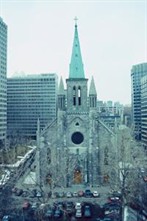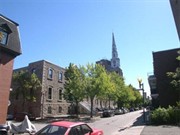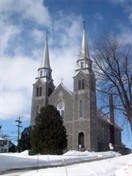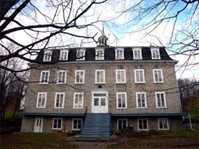Victor Bourgeau
Built across Canada, religious institutions have played an
important part in shaping our identity. In Montréal, before
the Quiet Revolution of the 1960s, churches were constructed across
the city to meet the spiritual needs of residents. In the 19th
century, one of the most prominent religious architects in Montréal
was Victor Bourgeau. His notable career is listed in the
Biographical Dictionary of Architects
in Canada.
Bourgeau was born in 1809 in Lavaltrie, Québec. Raised in a poor
family, Bourgeau was illiterate and did receive proper schooling.
In his teenage years, he worked for his uncle as an apprentice
joiner and carpenter. In the 1830s, it is thought that Bourgeau met
Angelo Pievoni, an Italian painter, who changed Bourgeau's career
path. Pievoni was possibly the one who taught Bourgeau
draughtsmanship and may have helped Bourgeau learn to read and
write. One thing is certain - an exceptional Canadian architect
emerged from obscurity.
His first religious commission was in 1839 in Boucherville,
where Bourgeau completed altar carvings and other decorative works
for several religious institutions. During that time, he was also
involved in smaller projects at the famous Notre-Dame Roman Catholic Church/Basilica
National Historic Sites of Canada in Montréal.
 With Bourgeau's growing
prominence in the early 1840s, Neo-Classical and Neo-Gothic styles
of architecture were popular in Montréal, and these styles would
resonate in his future work. Indeed, Bourgeau likely received some
architectural training under John Ostell, a popular architect in
the city, since an Ostell influence is present in Bourgeau's
designs of the period. To support this claim, Bourgeau eventually
finished some of Ostell's work after the latter could not continue
due to old age.
With Bourgeau's growing
prominence in the early 1840s, Neo-Classical and Neo-Gothic styles
of architecture were popular in Montréal, and these styles would
resonate in his future work. Indeed, Bourgeau likely received some
architectural training under John Ostell, a popular architect in
the city, since an Ostell influence is present in Bourgeau's
designs of the period. To support this claim, Bourgeau eventually
finished some of Ostell's work after the latter could not continue
due to old age.
Bourgeau's style can be described as predominantly Neo-Gothic
with a signature emphasis on façades with developed ornamentation
and belfries. Often copying British and American
architecture, his style was highly influenced by Thomas
Baillairgé.
It was in 1847 that Bourgeau made his name after the completion
of the St-Patrick Basilica National Historic Site of
Canada in Montréal. The church was constructed as a parish
for Irish immigrants and was constructed from 1843 to 1847 in a
French Gothic Revival style. Bourgeau was charged with supervising
the decorations in the interior of the church and the  results attracted much
attention.
results attracted much
attention.
In 1851, Bourgeau was the main architect for the Site
Historique de Saint-Pierre-Apôtre's presbytery and
church, which still stands today as one of the best examples of
Neo-Gothic architecture in Canada.
His greatest work were produced from 1857 to 1880, during which
period he was  commissioned to
redecorate the interior of Notre-Dame Roman Catholic
Church/Basilica National Historic Sites of Canada. By
staying true to his preferred style, Gothic Revival, one could say
that it made Bourgeau famous yet greatly upset the Catholic Church,
his most important client. Roman Catholics were concerned that the
Neo-Gothic style was too closely associated with Protestant church
designs in the city. From 1865 on, Bourgeau's churches, such as his
work on the Église de Saint-Raphaël-Archange, contained
Neo-Baroque and Neo-Roman characteristics because it was now the
preferred style for Roman Catholic architecture in Québec. He
subsequently monopolized religious institutional architecture in
Montréal from the 1850s to the 1880s with his new stylistic
preferences.
commissioned to
redecorate the interior of Notre-Dame Roman Catholic
Church/Basilica National Historic Sites of Canada. By
staying true to his preferred style, Gothic Revival, one could say
that it made Bourgeau famous yet greatly upset the Catholic Church,
his most important client. Roman Catholics were concerned that the
Neo-Gothic style was too closely associated with Protestant church
designs in the city. From 1865 on, Bourgeau's churches, such as his
work on the Église de Saint-Raphaël-Archange, contained
Neo-Baroque and Neo-Roman characteristics because it was now the
preferred style for Roman Catholic architecture in Québec. He
subsequently monopolized religious institutional architecture in
Montréal from the 1850s to the 1880s with his new stylistic
preferences.
Bourgeau was asked to be the principal architect for the
Marie-Reine-du-Monde-Cathedral National
Historic Site of Canada and was sent to Rome to study St.
Peter's Basilica in order to create a smaller replica for Montréal.
Bourgeau declined the offer, saying it was impossible to duplicate
such a masterpiece on a smaller scale while retaining its
authenticity. He did however agree to supervise Joseph Michaud, the
architect who took over the project.
In the 1870s, Bourgeau collaborated with Étienne-Alcibiade
Leprohon and began to work on projects other than churches.
Together, they were the head  architects for the Couvent de
Congrégation-de-Notre-Dame built for the Grey Nuns in
1877. This Second Empire style building attracted new clients and
helped Bourgeau expand his atelier before he died in 1888 at the
age of 78 while making a business call in Montréal.
architects for the Couvent de
Congrégation-de-Notre-Dame built for the Grey Nuns in
1877. This Second Empire style building attracted new clients and
helped Bourgeau expand his atelier before he died in 1888 at the
age of 78 while making a business call in Montréal.
Bourgeau was undeniably one of the greatest religious architects
of Montréal and his work still lives on because of protection and
designation of his churches by the City of Montréal and under
Quebec's Loi sur les biens culturels.
With over thirty historic buildings associated with his name on the
Canadian Register and a complete biographical entry on the
Biographical Dictionary of Canadian Architects since
1850, he deserves a distinguished place as one of Canada's
greatest architect since 1800.